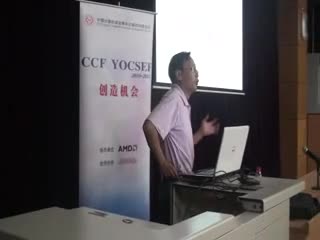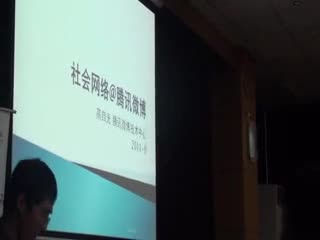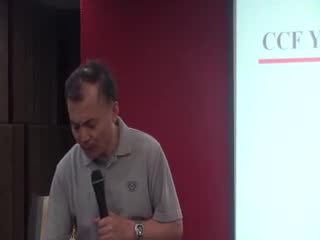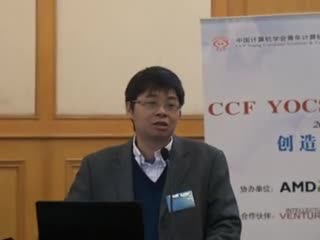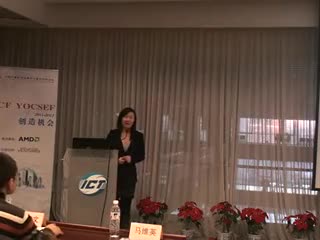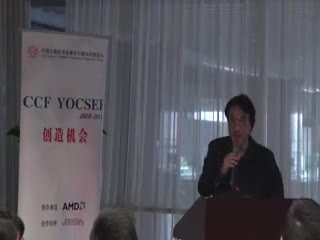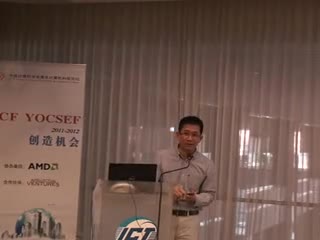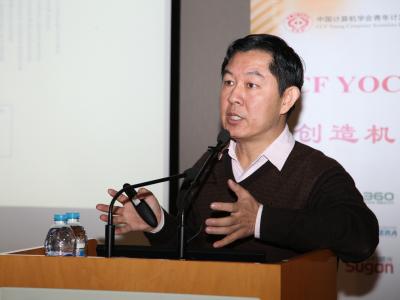中国计算机学会青年计算机科技论坛—重庆分论坛
CCF Young Computer Scientists & Engineers Forum-Chongqing Branch
CCF YOCSEF重庆
计算机科学与技术热点问题国际研讨会
将于2018年9月10日至11日
在西南大学博物馆4楼学术报告厅举行
一、 主办单位
CCF YOCSEF重庆(执行主席:郭松涛、章乐)
西南大学
承办单位
西南大学电子信息工程学院
二、 活动议程
9月10日 (星期一) | |
8:30-9:00 | 开幕式 |
9:00-9:20 | 合影 |
9:20-10:20 | 特邀报告 I: 题目:Future Computing Ecosystem: to be Inclusive + Specialized + Self-defined 报告人: 张晓东, 教授, IEEE/ACM Fellow, 美国俄亥俄州立大学 |
10:20-10:40 | 休息 |
10:40-11:40 | 特邀报告 II: 题目:Particle Natures of Classical and Quantum Waves and Signal Processing Circuits 报告人:Hisato Fujisaka, 教授, 日本广岛市立大学 |
11:40-14:30 | 午休 |
14:30-15:30 | 特邀报告 III: 题目: Computer Architecture and System Innovations for Enabling AI-based IoT Applications 报告人:李涛,教授, IEEE Fellow, 美国弗罗里达大学 |
15:30-16:30 | 特邀报告 IV: 题目: 区块链技术与应用 报告人: 仲盛,教授,国家杰青,中国南京大学 |
9月11日(星期二) | |
8:30-9:30 | 特邀报告V: 题目:MEMS technologies and their medical applications 报告人:Mitsuhiro Shikida, 教授, 日本广岛市立大学 |
9:30-10:30 | Keynote VI: 题目:Development of the Grass-root Information Distribution System based on MANET and Sensing Techniques for Reducing Damages of Landslide Disasters 报告人:Masahiro Nishi, 教授, 日本广岛市立大学 |
10:30-10:40 | 休息 |
10:40-11:40 | 特邀报告 VII: 题目:On dynamics of iterative sparse recovery algorithms 报告人: Kazushi Mimura, 教授, 日本广岛市立大学 |
三、 报告人简介及报告摘要
1.报告人 I: Xiaodong Zhang (张晓东) is the Robert M. Critchfield Professor in Engineering at the Ohio State University. His research interests focus on data management in computer and distributed systems. He has made strong efforts to transfer his academic research into the state-of-the-art technology to advance the design and implementation of general-purpose computing systems. He received his Ph.D. in Computer Science from University of Colorado at Boulder, where he received Distinguished Engineering Alumni Award in 2011. He has recently received Lutron Foundation’s Award for Excellence in Education Leadership. He is a Fellow of the ACM, and a Fellow of the IEEE.
特邀报告I摘要: The development of computing ecosystem in both hardware and software has been mainly driven by Moore’s Law that is ending. We are entering an era with a dramatic change to evolve into a new computing ecosystem where a variety of highly parallel, highly customized hardware accelerators co-exist with general purpose processors, such as GPU, FPGA, and ASIC. Our field are facing two fundamental challenges in the post Moore’s Law era. The first one is the crisis of machine’s and application’s complexities --- Developing software for high performance in computing and data processing on advanced hardware require increasingly sophisticated programming and optimization efforts in order to deliver highly optimized code, which is based on a deep human understanding of both underlying hardware architecture and application domain knowledge. The second one is the crisis of human resources. The human-based programming approach is not sustainable due to the shrinking of the talented software developers’ pool worldwide.
In this talk, I will envision the direction of the future computing ecosystem to address the above mentioned two crises. The computing environment will become inclusive to all the hardware accelerators under a uniformed management, where various specialized computing service in high performance and high efficiency will be provided. The computing environment will also be able to produce software by itself, which we call “software-defined software. We still have a long way get there, but we do not have other choice because existing computing ecosystem has become increasingly sophisticated to users and provide only general purpose computing in low efficiency.
2.报告人 II: H. Fujisaka received the Dr. Eng. degree from Keio University, Japan, in 1994. From 1994 to 1997, he was with the Department of Optical Communications, Osaki Electric Co. Ltd. In 1997, he joined the Faculty of Information Sciences, Hiroshima City University. Currently, he is a Professor in the Department of System Engineering. His research interests include analysis and synthesis of nonlinear signal processing and communication circuits. He is a member of IEEE and IEICE.
特邀报告II摘要: Quantum effect devices are potential successors of CMOS devices. In the design of signal processing circuits based on traditional classical wave theory, the use of active quantum effect devices requires representation of classical wave propagation by the flow of microscopic particles since the states of the devices are quantized. In simulating signal processing circuits consisting of both active and passive quantum devices, quantum wave propagation in the passive devices such as electron waveguides must be represented by probabilistic behavior of quantum particles. This lecture provides representation of classical and quantum waves by particles, building simulator models of quantum effect devices, and design of signal processing circuits with quantum effect devices.
3.报告人 III: 李涛博士是美国佛罗里达大学(University of Florida)工程学院电子与计算机工程系正教授(终身教职),首批杰出教授获得者,智能计算机体系结构设计实验室主任,IEEE Fellow。李涛博士2004年于美国德克萨斯大学奥斯汀分校获得计算机工程博士学位。2015年8月-2017年12月但任美国国家自然基金委员会(NSF)计算机信息科学与工程(CISE)学部项目主任。主要研究方向为计算机系统架构(含数据中心、云计算、大数据、物联网、及机器学习软硬件系统)和前瞻计算技术(类脑计算、内存计算、量子计算),高性能计算机体系结构(多核、GPU 、加速器)、 高效/可靠/低功耗微处理器及存储系统、面向云计算和大数据数据中心、虚拟化、并行与分布式计算、新型及可重构计算架构、面向特定应用(如:AI、大数据图计算、SDN/NFV)计算架构与芯片设计、多核容错处理器、片上互连网络、面向多众核的可扩展服务器体系架构、新型前瞻技术及应用对硬件,操作系统及系统软件的影响、嵌入式与片上系统、以及计算机系统性能评估等。
李涛博士在著名的国际期刊和计算机体系结构类一级国际会议 ISCA、MICRO、HPCA、ALPLOS、SIGMETRICS、PACT、DSN发表论文120余篇,获ICCD’17、Computer Architecture Letters’ 15、HPCA’11最佳论文奖。另外8篇论文被HPCA’18、HPCA’17、ICPP’16、CGO’14、DSN’11、MICRO’08、IISWC’07 和 MASCOTS’06会议程序委员会推荐参选“最佳论文奖”。李涛教授是HPCA名人堂(HPCA Hall of Fame)排名第一的全球华人科学家。 2013年获Yahoo!重大研究计划挑战奖。2009年获美国国家科学基金会杰出青年教授奖(NSF CAREER Award)。2008年,2007年,2006年均获 IBM 学院奖(IBM Faculty Award)。2008年获得美国微软研究院安全及可扩展多核计算机奖 (Safe and Scalable Multi-core Computing Award)。2006年获得微软研究院可信计算课程研究奖(Trustworthy Computing Curriculum Award)。 2012, 2014两度获佛罗里达大学工程学院年度最佳博士生论文导师奖。
特邀报告III摘要: In recent years, the artificial intelligence (AI) techniques, represented by deep neural networks (DNN), have demonstrated transformative impacts to modern Internet-of-Things (IoT) applications such as smart cities and smart transportation. With the increasing computing power and energy efficiency of mobile devices, there is a growing interest in performing AI-based IoT applications on mobile platforms. As a result, we believe the next-generation AI-based applications are pervasive across all platforms, ranging from central cloud data center to edge-side wearable and mobile devices.
However, we observe several architectural gaps that challenge the pervasive AI. First, the diversity of computing hardware resources and different end-user requirements present challenges to AI-based applications deployment on various IoT platforms, which results in inferior user satisfaction. Second, the traditional statically trained DNN model could not efficiently handle the dynamic data in the real IoT environments, which leads to low inference accuracy. Lastly, the training of DNN models still involves extensive human efforts to collect and label the large-scale dataset, which becomes impractical in IoT big data era where raw IoT data is largely un-labeled and un-categorized.
In this talk, I will introduce our recent research which enables pervasive AI-based IoT applications to become high-efficient, user-satisfactory, and intelligent. I will first introduce Pervasive AI, a user satisfaction-aware deep learning inference framework, to provide the best user satisfaction when migrating AI-based applications from Cloud to all kinds of platforms. Next, I will describe In-situ AI, a novel computing paradigm tailored to AI-based IoT applications. Finally, to achieve real intelligent (support autonomous learning) in IoT nodes, I will introduce an unsupervised GAN-based deep learning accelerator.
4.报告人 IV: 仲盛,耶鲁大学博士,曾在美国纽约州立大学布法罗分校任教并提前晋升终身教职。现任南京大学二级教授、博导,计算机系副主任、校人才工作办副主任,江苏省侨联副主席,江苏省政协委员。国家杰青、青年千人。ACM南京分会主席,IEEE Computer Society南京分会主席。兼任多家国际学术期刊编委。研究兴趣包括:密码学、博弈论及其在计算机网络、分布式系统中的应用。
特邀报告IV摘要: 区块链是当今最为热门的新技术之一。在此次报告中,我们将会首先简要回顾区块链的历史与来源。然后,我们将介绍其主要核心技术,包括其体系架构、工作量证明、共识与分叉、智能合约等等。基于这些技术,我们将分析区块链的优势与缺陷,讨论其在数字货币之中以及数字货币以外的应用。
5.报告人V: Mitsuhiro Shikida received the B.S. and the M.S. degrees in electrical engineering from Seikei University, Tokyo, Japan, in 1988 and 1990, respectively, and the Ph.D. degree from Nagoya University, Nagoya, Japan, in 1998. He was with Hitachi, Ltd., Tokyo from 1990 to 1995, and Nagoya University from 1995 to 2014. In 2014, he joined the Department of Biomedical Information Sciences, Hiroshima City University, as a Professor. His current research interests include integration of micro-sensors and actuators for intelligent systems, micro-fabrication of 3-D microstructures for bio-medical applications. He has published over 120peer-reviewed articles, over 180 presentations at international conferences, and 21patents. He holds journal editorial board memberships for IEE Letters Journal on Micro & Nano Technology, and Associate Editor for the Micromechanics Section for Sensors and Actuators A, Elsevier. He has served as Technical Program Committee at International Conference, IEEE-MEMS (2006and 2016), Transducers (2007 and 2013), IEEE-Sensors (2012-2018).
特邀报告V摘要: In order to reduce damages caused by landslide disasters, it is important for residents to quickly take refuge from the disasters. We consider that it is important to prepare the environment where the residents are able to decide appropriate timing for their evacuation. Our research group has proposed and developed the Grass-root Information Distribution System for monitoring landslide disasters using MANET (Mobile Ad-hoc NETwork) connected with mobile terminals, for the purpose of capturing landslide disasters information in the local area, delivering the information in the local MANET, and sharing the information among the local area residents. In our developed system, we have also constructed and operated the fixed type monitoring systems with the solar power supply in the dangerous places where the landslide disasters occurred in the past. By use of the infrared camera, the residents can visibly disasters occurred in the past. By use of the infrared camera, the residents can visibly monitor the dangerous places during night and day in the developed monitoring systems. In the workshop, we will show the overview of the Grass-root Information Distribution System based on the MANET and the several sensing techniques developed in fixed type monitoring systems.
6.报告人 VI: Masahiro Nishi received the B.E., M.E. and Ph. D. degrees in Communications Engineering from Osaka University, in 1995, 1997 and 1999 respectively. He joined Hiroshima City University (HCU) as a research associate in 1999.In 2005, he became an associate professor at HCU, and he was appointed to professor at HCU in 2016. He has been pursuing research on radio sciences, radio wave propagations and wireless network systems. He is a member of IEEE, the Institute of Electronics and Information Communication Engineers of Japan (IEICE), and the Information Processing Society of Japan (IPSJ).
特邀报告IV摘要: In order to reduce damages caused by landslide disasters, it is important for residents to quickly take refuge from the disasters. We consider that it is important to prepare the environment where the residents are able to decide appropriate timing for their evacuation. Our research group has proposed and developed the Grass-root Information Distribution System for monitoring landslide disasters using MANET (Mobile Ad-hoc NETwork) connected with mobile terminals, for the purpose of capturing landslide disasters information in the local area, delivering the information in the local MANET, and sharing the information among the local area residents. In our developed system, we have also constructed and operated the fixed type monitoring systems with the solar power supply in the dangerous places where the landslide disasters occurred in the past. By use of the infrared camera, the residents can visibly monitor the dangerous places during night and day in the developed monitoring systems. In the workshop, we will show the overview of the Grass-root Information Distribution System based on the MANET and the several sensing techniques developed in fixed type monitoring systems.
7.报告人 VII: Ph.D. (Science), Osaka University, 1999.Professor, Hiroshima City University, Japan, 2017.4-
特邀报告VII摘要: Approximate message passing (AMP) is an effective iterative sparse recovery algorithm for linear system models. Depending on a measurement matrix ensemble, AMP may face a convergence problem. To avoid this problem, orthogonal AMP, which uses de-correlation linear estimation and divergence-free non-linear estimation, was proposed. We derive a simple scalar recursion to characterize iterative sparse recovery algorithms with divergence-free estimators without such assumptions of independence of messages by using the generating functional analysis.
四、 参会方式
1 所有参会人员无需注册费,免费参会。
2 往返差旅费和住宿费自理。
五、 大会地址

交通指南:
地铁路线:坐地铁6号线到天生站,走3号口出站到西南大学
驾车路线:走重庆内环,到北环,然后上G75兰海高速,到北碚下道口下高速,然后经双柏立交到天生路西南大学。



